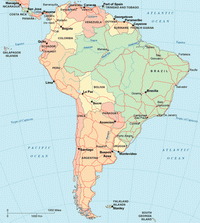Login form
South America
 South America is a continent of fascinating contrasts. It has huge cities, a rich culture, and modern buildings and industries. Yet South America remains the most mysterious and unexplored of the world’s inhabited continents.
South America is a continent of fascinating contrasts. It has huge cities, a rich culture, and modern buildings and industries. Yet South America remains the most mysterious and unexplored of the world’s inhabited continents.
THE FOURTH LARGEST CONTINENT
South America is the fourth largest of the world’s seven continents. Asia, Africa, and North America are larger. About 370 million people live in South America. That may sound like a lot, but it’s just 6 percent of the world’s population.
South America extends from the Caribbean Sea to the edge of the southernmost oceans. Brazil, South America’s largest country, is as close to Africa as it is to the United States! Ushuaia, in Argentina, is the world’s southernmost city.
There are 12 countries in South America. They are Argentina, Bolivia, Brazil, Chile, Colombia, Ecuador, Guyana, Paraguay, Peru, Suriname, Uruguay, and Venezuela.
ANDES MOUNTAINS
The Andes Mountains to the west run almost the entire length of South America. The Andes are one of the greatest mountain ranges in the world. Only the Himalayas of Asia are higher.
Some of the highest cities in the world are on the Altiplano, a treeless plateau in the Andes. The Altiplano reaches from Bolivia to southern Peru. Lake Titicaca, one of the biggest lakes in South America, is on the Altiplano.
THE MIGHTY AMAZON
The Amazon starts in the Andes Mountains in Peru and wanders 4,000 miles (6,400 kilometers) to the Atlantic Ocean. Most of the Amazon is in Brazil. It’s not the world’s longest river—the Nile in Africa is longer. But the Amazon carries more water than any other. In fact, 20 percent of the world’s fresh water flows through this great river!
The Amazon is surrounded by a huge rain forest that is mostly unexplored. The tops of the trees, a region called the canopy, is itself an undiscovered world. The forest is home to millions of plant and animal species, many of which are still unknown to people.
PATAGONIA
A land called Patagonia occupies the southern part of the continent. Here, cold winds sweep over a vast, treeless desert. The Patagonian Desert is the biggest desert in all of North and South America.
The name Patagonia comes from the Spanish word pata, which means “paw” or “foot.” Spanish explorers in the 1500s used the word to describe Indians living in the area because of their large feet.
ATACAMA DESERT
In northern Chile, between the Andes Mountains and the Pacific Ocean, is the Atacama Desert. It’s one of the driest places on Earth. Rain falls here just a few times every 100 years!
THE PAMPAS
A vast region of grassy plains, called the Pampas, stretch across central Argentina. They rise from the Atlantic Ocean and extend to the foot of the Andes Mountains.
Cowboys called gauchos once captured wild horses and tended herds of cattle on the Pampas. Most gauchos disappeared by the late 1800s as the cattle-raising business was modernized. But the gaucho lives on as a heroic figure in South American folklore and music.
ANGEL FALLS
Deep inside Venezuela is spectacular Angel Falls. It is the highest uninterrupted waterfall in the world. Water drops 3,212 feet (979 meters) from the top of the falls to the bottom.
The falls are named for James C. Angel, an adventurer from the United States. He spotted the falls from an airplane in 1935.
MIXED POPULATION
About half of all the people in South America live in Brazil, a country nearly as large as the United States. Brazil is home to enormous cities like Rio de Janeiro and São Paolo, the largest city in South America. But much of Brazil, along with much of the rest of South America, remains uninhabited.
People of many different backgrounds live in South America. But most people are related to three main groups: South America’s own native people, European settlers from Spain and Portugal, and Africans who are descendants of slaves. People of mixed European and Native American ancestry are known as mestizos.
Spanish is the official language of nine South American countries. But they speak Portuguese in Brazil, English in Guyana, Dutch in Suriname, and French in the territory of French Guiana. Throughout South America, millions of people still speak native languages such as Quechua and Aymara.
Source: Microsoft ® Encarta

